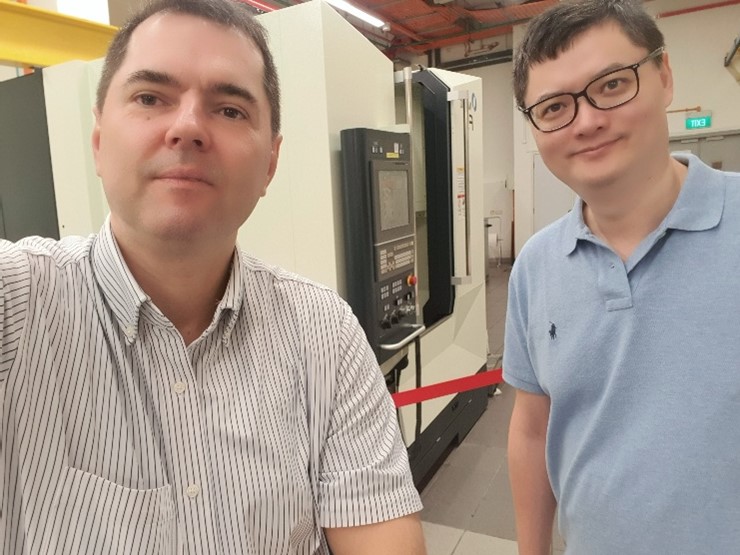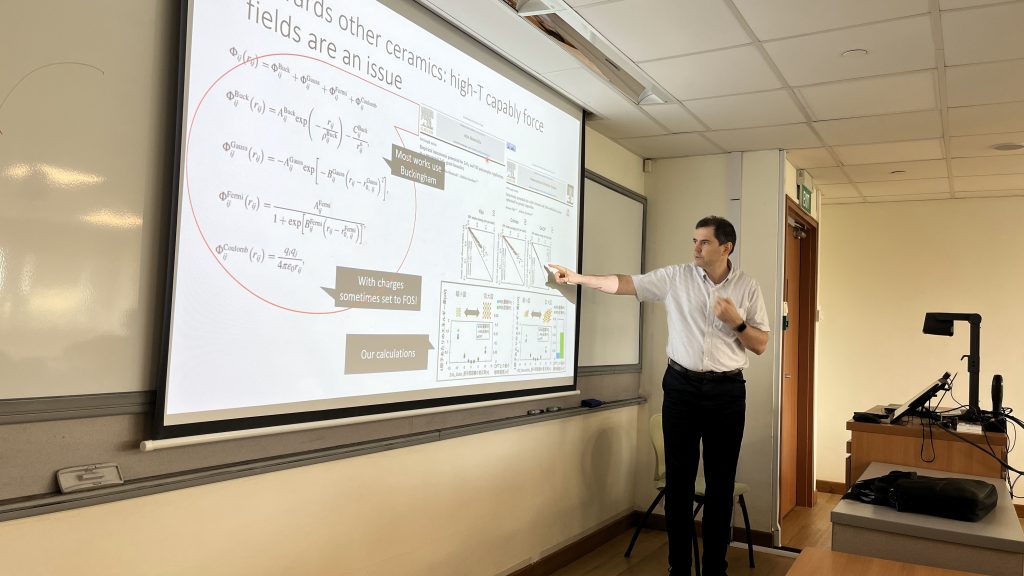2025.03.17
【WRH】 Associate Professor Sergei Manzhos visited National University of Singapore
Associate Professor Sergei Manzhos of the School of Materials and Chemical Technology has returned from visits to National University Singapore (NUS) supported by the WRH Faculty Research Abroad Program. This is a report on the activities and results of his stay.

Profs. Manzhos (left) and Wang (right) in the laboratory of Prof. Wang at National University of Singapore
| Awardee | Sergei Manzhos |
| Destination Institution | National University of Singapore |
| City and Country | Singapore |
| Host Researcher | Wang Hao, Associate Professor |
| Travel Period | 2024/12/12 – 2024/01/11, 2025/02/24 – 2025/03/15 (51 Days) |
| Project Title | Understanding and control of microstructure-driven properties of functional ceramics |

Prof. Manzhos effected two visits to the National University of Singapore (NUS) from December 13, 2024 to January 10, 2025 and from February 24 to March 15, 2025. Prof. Manzhos of Ihara-Manzhos laboratory and Prof. Wang Hao of the Department of Mechanical Engineering at NUS are collaborating on studies of microstructured ceramics. Ceramics are key functional materials in a variety of applications, from fuel cells, batteries and solar cells to optical devices and implants. Microstructure, in particular grain boundaries, are known to significantly influence key material properties including mechanical, optical, electron and ion transport, affecting all the above applications. To properly understand their effects, a combination of theory, modeling, and experiments is needed. The collaboration between Ihara-Manzhos and Wang labs is a synergy between computational modeling expertise in Ihara-Manzhos lab and experimental expertise in Wang lab. Part of the problem in studying microstructured ceramics is the sheer absence of adequate, nature-like grain boundary models. Experiments also do not allow adequate insight into the distribution of microstructural elements in the bulk of ceramics (as opposed to surfaces). Atomistic-scale computational models are therefore critically important but adequate models have been lacking. Another part of the problem is that even in the presence of more realistic models, computing their electronic properties (e.g. bandgap states due to GBs, or mechanism of ion transport) is difficult, as this is an intrinsically large-scale problem (as far as electronic structure modeling is concerned). It is in this area that Prof. Manzhos has expertise and know-hows. But models are only useful if they can explain real experiments, and mostly useful if they can predict novel phenomena or procedures that can be practically important. It is in this area that Prof. Wang has expertise and know how.
The present collaboration and visits under the WRH Program have built on previous collaborative research by the two labs [1,2]. During the visits, Prof. Manzhos worked with Prof. Wang’s group on the collaborative project, including calculations for the microstructure models of titania and lithiated titania that they have been developing; experimental research in Prof. Wang’s lab exploring our computational prediction of the possibility of reversible and non-destructive softening of ceramics by reversible ion ingress (in this case lithiation of titania), where the two sides spent time analyzing the results, planning additional experiments and calculations, and planning a manuscript. The collaborative team also worked on comparing models of microstructured titania that they developed with Voronoi tessellation-based models that have been used in the literature.
The visits also served to discuss plans for future research proposals, including applications in Singapore, Japan, as well as JSPS bilateral calls. Prof. Manzhos gave a seminar at NUS on the subject of the collaborative research and also visited other major universities in Singapore, SUTD (Singapore University of Technology and Design, where a seminar was given) and NTU (Nanyang Technological University) to discuss collaboration opportunities, including those related to large-scale atomistic simulations of microstructures and related properties as well as materials informatics.
[1] A. Sorkin, Y. Guo, M. Ihara, S. Manzhos, H. Wang, Non-invasive improvement of machining by reversible electrochemical doping: A proof of principle with computational modeling on the example of lithiation of TiO2, Mater. Chem. Phys. 295 (2023) 127183. https://doi.org/10.1016/j.matchemphys.2022.127183.
[2] T. Okamoto, A. Sorkin, K. Kameda, M. Ihara, H. Wang, S. Manzhos, Natural-like generation of grain boundary models and the combined effects of microstructural elements and lithiation on the plastic behavior of TiO2: A computational study, Comput. Mater. Sci. 239 (2024) 112989. https://doi.org/10.1016/j.commatsci.2024.112989.
Related links:
– World Research Hub (WRH) Program
– Sergei Manzhos

